|
|
Dutch
Hill Dutch Mountain Heartwellville, VT 1944-1985 |
History ~ 1954 Vermont Life Article ~ By The Year ~ Historical Imagery ~ More Recent Photos ~ Memories
|
|
Dutch
Hill Dutch Mountain Heartwellville, VT 1944-1985 |
History ~ 1954 Vermont Life Article ~ By The Year ~ Historical Imagery ~ More Recent Photos ~ Memories
| Before we get into a deep
history of the area, here is a quick synopsis and description of Dutch
Hill. Dutch Hill was a popular,
well liked mid sized ski area that operated in extreme southern Vermont,
from 1944 to 1985. It reflected many of the small and mid sized areas
the opened in Vermont and New England in the 1940's into the 1960's.
Similar ski areas include
Snow Valley, VT
and Hogback, VT. At
its peak, it had a 570' vertical drop, T-bar, J-bar, and rope tow, and
about a dozen trails of all difficulty levels. It was a compact area
with a main lodge at the base of the T-bar and a smaller lodge at the
base of the beginner area. The lower northern side included the "Dutch Meadows" slope, which was served by an original J-bar and rope tow. Earlier, it had been served by a longer rope tow. Later, a cafeteria called the Dutch Treat was added here. The main portion of the ski area was served by a 2000' Roebling T-bar, and about 5 main trails - the novice Dyke, the intermediate Yankee Doodle, the novice-intermediate Dutchman's Holiday, and the VERY steep Windmill and Christiana. Another trail, the Ski Lark, was cut off from the Christiana and was accessible via Yankee Doodle. In later years, a new trail, Dutch Meadows Extension, was added. On the right, you can see the aerial view in 1992. For more information on the trails, there are numerous maps below. |
|
|
|
The topo map on the left shows the area, with a summit of about 2460', and a base of about 1906', giving a vertical of nearly 570'. Across the street is the Alpenwald development, which is showing a rebirth in the 2000's. |
Dutch Hill was founded by Web Ottman and several partners in 1943. Mr. Ottman passed away in 1979, and his wife Madelon Mulroney Ottman, passed away in April of 2009. Here is a link to her obituary which has more information on her life.
Madelon had sent us a very detailed history of Dutch Hill through her niece, Mary Baker. This history is below - all of it is Madelon's, through 1968. After 1968 are my notes. I have used pictures from various sources to help illustrate the history. Enjoy!
1930’s
It all started when Webster Ottman joined the North Adams Ski Club. His son, Roger had become interested in skiing and this was the ideal way to start.
In the following years, the Club membership grew – “Skiing had invaded the Berkshires!” Bus trips to various areas, “Snow Valley”, “Bromley” and “Pico” in Vermont; “Farnhams”, Bousquets”, and Chickley Alps” in Massachusetts were enjoyed; all areas were well patronized. Club Races were held, social events such as a yearly “Snow Ball” attracted members and attendance remained high.
A few of the older men in the Club – including Web Ottman, who was president, and fellow officers, David Allen, Edson Clark and Madelon Mulroney and others, decided to look into the feasibility of having their own (Club) ski tow. Members agreed. After a rope tow was found, owned by Donald Canedy and operated at the Whitcomb summit on the Mohawk Trail, it was purchased by the Ski Club.
An agreement was made with Harry Bernard, who owned a farm on the shoulder of Mount Greylock, to use his land. Adding to the Canedy tow, a 1200’ rope tow was built by members. 3 trails, 1700’ 1800’, & 1400’ were cleared along with a wide-open slope. A ski hut of logs was built. Women members as well as men contributed time and labor to build the facilities. The Club remained very active and attracted younger members also.
1943
Mr. Ottman, seeing a future in skiing, searched several locations and finally decided that Heartwellville, Vermont would be ideal. He purchased 46 acres from the Connecticut River Valley Corporation which included “Dutch Hill”. The mountain was 2470’ at the top, 1900’ at the base, had a 570’ vertical drop and was in the 110” snow belt. An ideal spot! It also faced north-northwest, again an asset! “Dutch Hill” was so named for the Dutch farmers who settled in the late 1700’s hoping to avoid malaria which prevailed at lower elevations.
Heartwellville is located only 5 miles from the Massachusetts border.
Sharing Mr. Ottman’s enthusiasm, David Allen, James Lockwood and Harry Short joined him as partners. Clearing began on the mountain – work was performed by the four men with help from their families and volunteers from the Ski Club.
1943 – 1944
A 1000’ rope tow, powered by a Ford Motor, (still on its chassie), opened on December 22, 1944 (Mr. Ottman’s birthday). It was located on the East side of the partially cleared “Ski lark” and ran to the unused “Dutch Hill” road. Four trails- novice “Dyke”, intermediate “Yankee Doodle” and expert “Christiana” could be used. Trails were narrow and rough. 30 skiers appeared that weekend. Tickets were $1.00.
The tow ran weekends, holidays and holiday weeks. Snow conditions were very good. Closed March 31. 500 skiers used the tow during the winter!
|
1944-1945 A rough warming “hut” heated by a “pot bellied stove” provided a shelter. Sitting about 50 skiers. Hot chocolate and soup were offered. The tow was lengthened to 1200’, the path improved. Clearing began again on the trails. Encouraged by the interest, Ottman and Allen wanted to enlarge. Lockwood and Short did not and sold their shares to the two remaining partners. (Right - a Dutch Hill patch from Jim Clarke) |
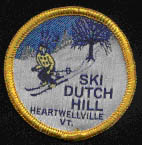 |
|
1945, 1946, 1947 In August 1945, two new partners joined Ottman and Allen. John Pedercini, (a coal dealer) and Edward Dondi (owner of two restaurants) were both successful North Adams businessmen. (This partnership lasted 24 years successfully.) Both men were “silent” partners. Judge Earnest Rosasco, was hired as attorney, and Miss Madelon Mulroney, a Berkshire skier, who had also been an officer in the North Adams Ski Club, as secretary and to handle publicity. Webster Ottman was to remain as general manager. Mr. Allen, who was a draftsman with Hunter Machine in North Adams, remained at his job, working at the area weekends and holidays. (Bud Kroll sent us this photo on the left of his mother at Dutch Hill in December 1944 or January 1945. Click on it to see the larger version.)
|
|
Fifty-five more acres were purchased to widen and
lengthen the “Dutchman’s Holiday” trail. (Over the years, two hundred sixty
more acres were purchased making the total acreage 380 acres.) A Constam 2000’
T-Bar lift to carry 800 skiers per hour was purchased from John A. Roebling of
Trenton, New Jersey. As new bulldozers or like equipment were unavailable, the
lift line was extended to the mountaintop, steel towers were hauled up by
horses, including the bull-wheel and ¾” cable. Horses were used in the cutting,
clearing of the trails; all 5 trails were extended to the top also. (An ancient
International bulldozer helped.) “The Dutch Boot”, a warming building to seat 200 skiers, was constructed. A cafeteria and kitchen were upstairs. Downstairs, a ski shop “Dutch Oven” for rentals and accessories, first aid room, and modern rest rooms were completed. Covered with inexpensive blue shingles, unfinished inside it also boasted a beautiful field stone fireplace and an oil furnace for added heat! About this time (1946), the hard cover, “Treasury of Vermont Life” included a picture of the “Yankee Doodle” in the collection. (Right - an undated early postcard of the Roebling T-bar, from Laurie Puliafico) |
|
|
|
1947 A new road was constructed from the Stamford line due to increased traffic flow. The new novice trail “Dutch Meadows” was cleared and the 1200’ tow was lengthened to 1400’ to service the new area. Beginning on January 1, 1947, the T-Bar operated daily. Good snow continued all winter allowing an operation of 90 days. The area closed April 7, 1947. • Stem Turns: Frank Elkins – ski writer for New York Times - “Lavish Area”. • Another ski writer: “Dutch Hill development was one of the ‘topnotch’ ski areas in New England”. • “Berkshire Eagle” ski writer wrote “Dutch Hill’s ‘Dyke Trail’ and ‘Dutch Meadows’ “Finest novice areas in Vermont ”! • 10th Mountain ski troops skied Dutch Hill. • 3 skiers flew up from Florida! • Web and Gordon Lowe, USEASA Instructor, spoke to local schools asking them to have skiing in the athletic program. • High schools nearby were offered free skiing every Tuesday. • Signs were placed at the top of each trail or slope to inform skiers of degree of difficulty. • Ski patrol unit was formed.
|
1947, 1948 & 1949
|
During the next three years, a parking lot was constructed to hold 500 cars. Work continued on clearing and widening trails and slopes. Smoothing and regrading and seeding so that they needed less snow, were safer, and could be mowed with a mowing machine. The two expert trails were mowed by hand. A 14,000-gallon reservoir was built fed by a generous spring to take care of the needs of the “Dutch Boot”. A larger office was added upstairs. Each year monies received were “plowed” back into the area. As crowds increased, it was deemed necessary to continue to improve the skiing – by easing corners, wider trails. Trails and slopes were “broken out” by instructors and ski patrol. (Right - a 1948 trail map, courtesy of Laure Puliafico. Click on it for the larger version. Also shows the Dutch Boot Lodge).
|
1950-1951
|
|
“Trail” skiing was becoming more “open slope” type
skiing. Parking lot was again increased to hold 50 more cars. An electric
timer was installed for races. Ski trains arrived in North Adams. Skiers were
bussed to Dutch Hill. “Dutch Hill” was proclaimed one of “the Best Areas in
New England!” The “Ski Lark”, an intermediate slope, was cleared. “Dutch Hill”
float won the first prize in the North Adams “Fall Foliage” parade in September. (Left - a c1950 trail map sent to NELSAP by William Phillips, showing the newly cleared Ski Lark Trail. Below-a 1951 ad in the Eastern Ski Map)
|
|
1952-1953-1954 The ‘Dutch Oven” ski shop was enlarged – more rentals were added. The “Yankee Doodle” was widened 100’ on a narrow corner, 100 cases of dynamite were used to break down the ledge. Dyke trail was also widened and groomed. Concealed ditches were placed on the “Christy” and “Windmill” to help prevent erosion. Tons of earth was brought from the area near the “Meadows” and “painfully” dumped on the top of the trails and shoveled down. Four acres of slope became the “Dutch Meadows” novice area and was completely widened, groomed and seeded. A 400’ “baby” rope was installed on the “Meadows” parallel to the longer tow. (Right - a 1951 North Adams brochure shows the trails and facilities. Below - an ad from that same brochure talks about the Ski Shop).
|
|
|
1955 The “Boot” was recovered with wood siding and painted yellow. David Allen paneled the inside with knotty pine. A room was added under the office. A garage was added to the T-bar lift house for equipment. “Sun Deck” was added to the south side of the “Boot”. Office was enlarged. Bob Curley named “Dutch Hill” ‘Little Stowe”. He was a ski writer for the Herald News of Passaic, New Jersey. (Left - a view from the top of the Yankee Doodle intermediate trail, likely 1950's, thanks to Laurie Puliafico. Click on image for larger version) |
|
1956 - 1957 A 1300 ‘ “Ottman-Allen” J-Bar was installed on the “Dutch Meadow” replacing the long rope tow. “Baby” rope remained. The “Dutch Treat” similar to the “Boot” was built to service skiers using the novice “Dutch Meadows”. It contained a huge fieldstone fireplace, rest rooms, and cafeteria. A playroom for baby sitters was located downstairs. Parking again increased to hold 600 cars. A blind skier following her instructor’s bells (on ski poles) enjoyed the “meadow” often. “Berkshire Interscholastic” races were held successfully in February – eighteen schools took part. (Right - skiers riding up the 1300' Ottman-Allen J-bar. Courtesy Laurie Puliafico). |
|
|
1958-1959 Skirts and shorts became the spring fashion. Photos were carried on the “AP” wires. Vacation plans with hotels, motels and ski lodges proved successful. “Learn to Ski Weeks” were also offered. (Right - a trail map from 1959, courtesy of the New England Ski Museum. Click on image for larger version). |
1960-1964
|
|
A junior racing team coached by Jack Dempsey, former Norwich ski team captain, representing “Dutch Hill” placed well in junior races throughout New England for several winters. “Packers” 2 OC-3 Oliver tractors-tracks were covered with 2x8” planks – waxed- and used for packing the novice and intermediate areas. These were slow moving but faster than “man” packing and proved very useful. The patrol and instructors “sidestepped” the expert trails. (Various companies were producing vehicles used in the army – but these were not completely successful in steep terrain.) |
To relieve congestion at the T-bar entrance line, trees were removed. Forty young spruce trees were planted on either side of the T-bar line to help break wind sweep on the lift line. An electric motor was installed in the J-Bar and also the T-Bar. The T-bar building was remodeled and a new ticket office added. A bigger garage was built for equipment. Through Ottman’s persistent efforts, Route 100 was extended to the Stamford, Vermont line becoming Route 8 and 100 and of course included “Dutch Hill”! Route 100 reached many ski areas and was titled “Skiway” highway.
A Thiokol Packer was purchased and could pack the entire area.
1964-1968
|
Dog sled rides were enjoyed by “non-skiers”. In 1967, Morton Lund’s Skiers Paradise – a hard cover book, included the windmill trail with the 100 most famous trails in North America! Dutch Hill continued to draw good crowds – the snow reports were downplayed. “Excellent” was never used and skiers appreciated the honesty. It was a family area that produced many fine skiers. It was widely said that “if you could ski the ‘Windmill” or ‘Christiana”, you could ski any mountain!” Famous celebrities who visited or skied at Dutch Hill included Celeste Holm who loved the “Meadows”, Lowell Thomas – the “windmill’. Doris Day was a spectator and several members of the press, TV and radio visited often. (Left - a 1964 trail map. Click on image for the larger version). |
Dutch had good snow most years. For three years total operation was only 90 days. Careful grooming paid off! Except for the 3 bad winters, Dutch’s average operation was from 90 to 120 days.
Dutch always received “Good Press” from the ski writers – from New Jersey, New York, Pennsylvania and Massachusetts. A 16mm color film was offered free to ski clubs, of which there were many – even shown by American troops in Russia! (20 minutes in length). 15,000 to 20,000 brochures were distributed each year to ski shops, ski writers, radio and TV ski reporters. A newsletter was published yearly to all of the above. 1,500 postcards with snow reports weekly through the operating season attracted much interest to skiers and the media each year.
News coverage ranged from the Boston, Worcester, Springfield, North Adams Transcript, Berkshire Pittsfield Eagle, New York times, Herald-Daily News – 2 New Jersey papers, Penna, Bennington Banner and Brattleboro - Rutland, VT
Dutch had good relations with “Hogback’s” president John Dunham. Jiminy Peak’s 4 partners Clark, Fisher, Drummond and Hendricks. Dave Judson of “Otis Ridge” and many more.
“Dutch” was a pioneer area in every respect. Mr. Ottman was a firm believer in preventive maintenance. The area’s attraction: it offered well-groomed trails and slopes, easy riding lifts, reliable snow condition reports, and a family atmosphere. The buildings were clean and attractive. Food was good (some homemade). The staff was polite and the service “good”. The “Dutch Oven” ski shop personnel were also friendly and helpful. In fact everyone employed at the area made the skiers feel welcomed. I wish I could name them all! The ski patrol well trained and competent; the instructors were fine teachers.
Carrying out the “Dutch” theme made for good press and conversation. In fact Dutch delegation from the United Nations in New York were frequent visitors. Yes, they skied, not skated!
It was not always easy. Ski areas are often compared with farmers: both deal with uncertain weather. Snowstorms on a weekend, rain on a Friday, icy conditions, were not always fun.
Weekends meant being at the area at 4 AM to make sure all was ready to go and last minute plowing or packing. By today’s standards, things were pretty rough!
1968
As “Dutch” was at its peak and the partnership members were aging, it was deemed practical to sell the area. So in October 1968 the area was sold. Mr. Ottman and I stayed a few months and as we were both tired, decided to retire.
NOTE: I was hired as secretary, bookkeeper, to handle business needs. It became evident that “publicity” was a must! And snow reporting our lifeline to skiers. Having some experience in promotion and with the kindly help of newsmen and women, the media in general, I learned a lot, fast! My little “Dutch Boy” soon became famous and much of my weekly postcards were used by press – TV and radio! I always loved to write – so that part was easy! Trips in the fall to ski shops, leaving brochures proved helpful – included were New York City, Westchester, Tri City, Springfield, Hartford – to name a few. Also shops within 150 miles of Dutch Hill. Several hundred ski clubs and like groups were also a great market.
During the summer I had plenty of time to work on publicity. But, I also learned to paint buildings, towers, equipment, and to learn to drive the OC-3’s (Oliver Tractor), rake trails, drive a tractor drawn sledge so the men could load stones to be dumped elsewhere. Also to use dynamite on the ledge, for the base of the towers, whole corner of the “Yankee Doodle”, tree stumps and large boulders on the trail sections. I enjoyed it all!
After 1968
While the above is from Madelon Ottman, the rest is written by Jeremy using evidence from readers, visits, etc.
During the 1970's, Dutch Hill started to go through some tough times. The total number of Vermont ski areas peaked in the early 1970's, then fell rapidly. Many of these lost areas were community rope tows.
Dutch Hill found itself with increasing nearby competition, with areas providing facilities that Dutch Hill could not. These areas included Brodie, Jiminy Peak, and especially Mt. Snow to the north. Dutch Hill was caught between these areas. They never offered snowmaking or night skiing, but continued to offer a quality ski experience, with a good beginner area and some tough trails.
In 1977, the owners decided on a name change to Dutch Mountain in order to sound just a little bit bigger. A few new trails were added. Dutch Meadows was expanded uphill, a Chalet Access trail was developed, and Tulip Lane, a short connector from the Dyke Trail to the J-bar was named.
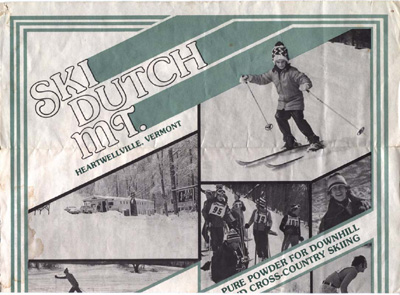 |
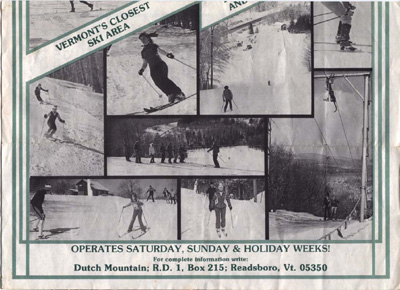 |
| An early 1980's brochure, thanks to Dwight Boerem. These are from the front. Click on images for larger. | |
| More from the brochure, including the trail map. Click on both for larger images. | |
A development across the street called Alpenwald was begun. This was to raise revenue for the owners.
Finally, in 1985, the owners decided to close the ski area. Bad snow years, competition, and changing ski habits all took their toll. The Alpenwald development was generally stopped (but has recently began a resurgence). In 1990, all the buildings were burned for practice for local firefighers. The area was marked private property until 1999, when it was sold or traded to the state. All man-made structures were removed. The good news - it is completely open to the public. Trails have grown in very quickly, but Dutch Meadows is still somewhat clear.
The following is a paraphrase of an article written in 1954 by J. Howard Buffum, Jr., for Vermont Life.
| Webster Ottman had
an idea in 1943: to open a "Little Stowe", closer to southern Vermont.
He found it in Dutch Hill. During the 4th of July in 1944, the first trails
and slopes were cut on Dutch Hill. The Dutch Hill Ski Area, in Heartwellville,
VT, opened on November, 1944, with several slopes and trails served by
a 1000 foot rope tow. Things were ran rather hapharzdly at first, as the
small lodge had no running water or electricity. The area changed in management,
but the goal remained the same, to develop this area into a fine ski center.
A Constam T-bar was purchased, and on January 4, 1947, the first skiers
rode up this 2000 foot long lift.
This lift could only haul 600 skiers per hour, and many of the trails it served were rough and unfinished. Traffic was a mess, and the lodge was cramped. No matter, the 102 days of skiing provided many with hours of enjoyment. The season lasted from New Year's Day to around April 1st. In 1948, the parking area along the highway was increased in size and a 14,000 gallon water storage reservoir was installed.
|
|
|
|
Over the next few years, the Dutch Meadows slope was widened and graded, and the original rope tow was reinstalled. This beginner slope was 1400 feet long and 200-300 feet wide. The new tow pulled 1,000 skiers per hour at 12 to 14 miles per hour. In 1949 a bigger motor was installed to the T-bar and more T's were added so its capacity rose to over 800 skiers per hour. |
| The base lodge had
some character. It was named the Dutch Boot, and had a massive fieldstone
fireplace. There was a Dutch Oven Ski Shop, first aid room, and restrooms.
It even had an area so that skiers that brought their lunches could sit
and eat.
The most popular ski trail is the Dyke, the mile long novice trail which passes over the top of Dutch Meadows, giving skiers a chance to break off onto other trails. On the opposite side of the hill is the Dutchman's Holiday, a 1.5 mile novice-intermediate trail. In between these two trails are the 3/4 mile Yankee Doodle (int.) and the expert Christiana and Windmill trails. Off of the Christie trail is the 0.4 mile long Ski Lark, a wide intermediate trail. In 1953 the Ski Lark and Yankee Doodle trail were smoothed out. The upper part of Dyke was also smoothed out, as well as the Dutchman's Holiday.
|
|
By The Year This is a listing of details by the year - but the above history is more complete.
| Year | Lifts | Trails | Other Information | Source |
| 1943 | none | none | Webster Ottman comes up with the idea of opening a ski area on Dutch Hill | Vermont Life article, "Haven for Trail Skiers", by J. Howard Buffum, Jr., winter 1954 |
| 1944 | 1000ft rope tow | narrow slopes/trails near future T-bar area | Trails cleared on 4th of July, area opens in November | same as above |
| 1946-1947 | 1000ft rope tow, new 1985ft Constam T-bar (600 skiers/hour) | new trails to summit, new beginner slope on Dutch Meadows | Rope tow moved to Dutch Meadows, a beginner area. Dutch Hill sets a record ski season of 102 days | same as above |
| 1948 | same | 6, plus two ski school slopes | Parking area extended along main highway; Dutch Meadows slope widened and graded to provide smooth skiing; improved rope tow now pulls skiers at 12-14 miles per hour | same as above |
| 1949 | same | 7, with new intermediate Ski Lark trail added | Bigger motor installed on T-bar, with new capacity 810-820 skier/hour | Vermont Life article 1954, brochure |
| 1958-1959 | 1200' J-bar, 1985' T-bar, 400' rope tow | same | New J-bar installed, rope tow shortened and moved to parallel J-bar to serve beginner skier, more parking | Vermont LIfe Article "How to Get the Most from Vermont Skiing", by Murray Hoyt, winter 1958-1959 |
| 1963-1964 | same, lift capacity 1700 skiers/hour, T-bar operates daily while other lifts are weekend only | same, 6 miles of skiing | N-NW exposure, 110" average snowfall; summit elevation 2470 feet; vertical drop 570 feet; 3 packers. Lift tickets $4.00 all day adult, $3.00 1/2day, $2.00 at 3pm, $3.00 juniors | brochure |
| 1968 | additional rope tow added between 1964 and 1968, with length 350' | same | Rates, $5.00 daily adults, $3.00 juniors | unknown ski guide, VT Tramway Report, 1974 |
| 1973 | 350' rope tow removed, capacity now 2000 skiers/hour | 8 trails | Area now operates weekends and holidays only. Family area, no snowmaking, 12 ski instructors; parking for 500 cars. Rates: $6.00 adults, $4.00 juniors | Ski Guide to the Northeast, VT Tramway Report, 1974 |
| 1977-1978 | same | 8 or 9 trails | Now called Dutch Mountain | VT Tramway Report, 1977-1978 |
| 1978-1979 | same | 9 trails | Dutch Mountain listed for sale | Colorado Skier Newsletters |
| 1981-1982 | same | 9 trails | Renames itself Dutch Hill | VT Tramway Report, 1981-1982 |
| 1984-1985 | same | same | Dutch Hill closes for good | VT Tramway Report, 1985 |
| 1990 | Base lodge burned to the ground for practice by the Readsboro Fire Department | "Dutch Hill Now a Memory", by Barbara Coe, Aug 30, 1999, North Adams Transcript. Provided by Jeff Strait | ||
| 1999 | All man-made remnants removed, mountain returns to its natural state | above |
| Another picture of Bud Kroll's mother from December 1944 or January 1945. Click on the image for the larger version. |
|
|
Dan Axtell sent us this aerial postcard view of the area. Date unknown, but probably 1950's or 1960's. Note the wide variety of trails and slopes. |
| A view of the original beginner area, to the left of the T-bar at the bottom of the Ski Lark slope. Year unknown. |
|
|
|
The ski school, probably 1950's, thanks to Laurie Puliafico. |
| Wesley Wright from the Ski Vermont Discussion Forum let us use this picture, showing the J-bar (right) and beginner rope tow (left), and a ticket booth. |
|
|
|
Laurie Puliafico sent us a postcard of the Dutch Hill sign. Likely late 1950's or 1960's. |
|
|
|
Neumann Family Collection
The following high quality, color slides of Dutch Hill are from the Neumann Family Collection, provided by Cindy Beck. Take by Bill Neumann, they are undated, but are circa late 1940's, and show some nice views of the slopes and the lifts. Please click on each for a larger version.
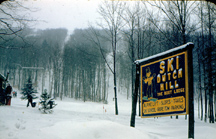 |
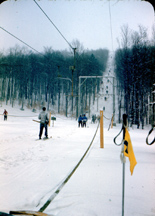 |
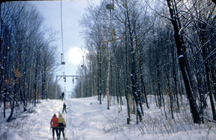 |
| Base of the ski area, showing the Dutch Hill sign and T-bar. Slope to the right is the Windmill. | The T-bar. | Riding the T-bar - likely closer to the top. |
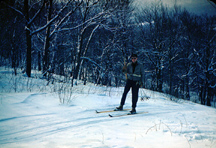 |
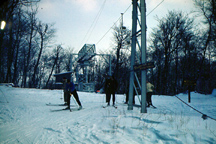 |
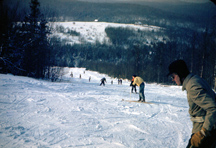 |
| Riding the T-bar - likely at the summit. | Summit unload. | Likely Dutch Meadows slope. |
Blair Mahar's Photos
Thanks to Blair Mahar who sent in these great black and white photos of Dutch Hill - showing the lift, near the base lodge, ski school, and what appears to be a costume party on the slopes and obstacle course. Click on each for a larger version.
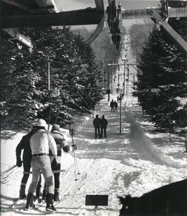 |
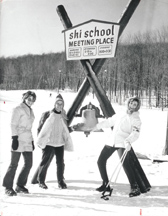 |
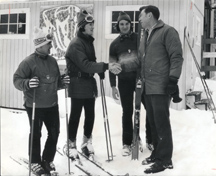 |
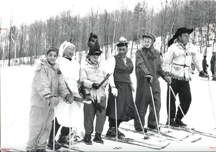 |
| Looking up the T-bar lift line. | Ski School meeting place. | Skies near a base building..note the trail map in the back. | Costume party. |
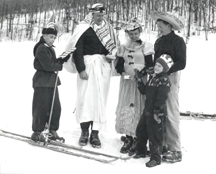 |
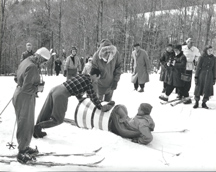 |
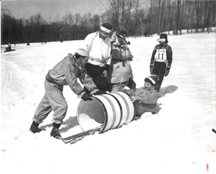 |
| Costume party. | Obstacle course. | Obstacle course. |
1998
These
pictures were taken in June of 1998 when my friend Chris Seneta and I scoped
out the area. The area was marked "no
trespassing" then, before the land was turned over to the state. These
probably some of the last shots of any man-made parts of the hill. All
man-made items were removed the following year.
| The T-bar engine foundations and lift line. Note some of the junk that had been dumped on the site. A few T-bar towers were standing in 1998. |
|
|
|
The remnants of the base lodge. At that point, the chimney was the only portion still remaining. |
| The mostly clear Dutch Meadows Slope. |
|
|
|
The remains of the Dutch Treat Cafeteria, near the base of the J-bar. A few J-bar towers were still standing in 1998. Sign reads "For Sale-Ski Area". |
2001-Winter
| Betsy McDonough took a few shots of the area in early 2001. Here we see the J-bar liftline (far left), and a view of the Christian trail (middle) and Windmill trail (far right). |
|
|
|
The Christian trail (left), T-bar liftline (middle), and Windmill Trail (far right). |
2001-Fall
I had a quick visit in the fall of 2001, and hiked up the J-bar. While no towers remain, the counterweight at the top of the lift is still there!
|
|
Looking up the J-bar lift line. |
| The counterweight at the top of the J-bar. |
|
|
|
Looking down Dutch Meadow. |
October 2005
| I stopped by the
area again on a cool and wet day in October 2005, and got soaked
walking around the base area. To the right is a view of the rapidly growing in Windmill Trail and T-bar liftline. |
|
|
|
A closer shot of the T-bar liftline. |
| Looking towards the old Dutch Boot lodge, near the Birch Tree. |
|
|
|
The site of the former Dutch Boot Lodge. |
| A post between two trees near the Dutch Boot Lodge. Surely this used to hold a sign of some sort. |
|
|
|
The Windmill Trail continues to grow in. |
March 8, 2006
| Jon Regan visited the area briefly on March 8, 2006, and took the following two photos. This shot here shows the liftline - still relatively clear. Click on photo for larger version. |
| This shot shows the steep Windmill Trail. Click on image for larger version. |
Coming Soon!
Last updated: November 27, 2013